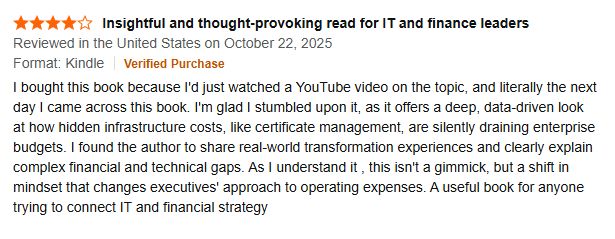Book Launch: Making Infrastructure Costs Visible for Startups
 The recent launch of “$15M Line Item That Doesn’t Exist” reveals a clear need for better understanding of certificate management’s financial impact.
The recent launch of “$15M Line Item That Doesn’t Exist” reveals a clear need for better understanding of certificate management’s financial impact.
The recent publication of my book “$15M Line Item That Doesn’t Exist” on Amazon has been off to a great start with over 50 downloads globally in just a few days after release. The feedback in the reviews has been highly specific, highlighting a clear need for better understanding of certificate management’s financial impact.
As one reviewer noted, she purchased the book because she had just watched a YouTube video on infrastructure costs and literally the next day discovered this book. She learned that complex financial and technical gaps create massive cost sinks, and that addressing certificate management isn’t a gimmick but a fundamental shift in how executives approach operating expenses.
Another reviewer observed that while the information is clear and accessible to non-experts, “this is not something that’s going to apply to a broad array of people, but as I said, for those who need it, it’s a good resource.”
That comment captures exactly why we at Axon Shield are determined to raise awareness. The reality is that this concept applies to a much broader range of organizations than most people realize. They simply don’t know it yet.
Here’s what every startup founder needs to understand: certificate management reveals whether your company is truly ready for institutional contracts. When universities or enterprises ask for your complete certificate inventory during procurement, they’re not checking a compliance box. They’re evaluating whether you can operate reliably at scale.
One reviewer wrote that the book “doesn’t just discuss technology; it reshapes the mindset around financial accountability in IT.” This mindset shift matters most for startups because you’re building infrastructure foundations while pursuing growth. The choices you make today determine whether you’ll scramble during procurement tomorrow or close deals while competitors gather documentation.
The financial case is straightforward once invisible costs become visible. Organizations typically spend between $1,000 and $3,000 per certificate annually when accounting for labor, opportunity costs, and incidents. Automation drops this to $15-$25 per certificate. But the strategic value extends beyond cost savings. You gain infrastructure intelligence that accelerates incident response, enables security-by-default architectures, and provides the operational maturity that procurement teams require.
This applies broadly because every organization managing digital infrastructure faces these costs. The difference lies in visibility. Enterprises with dedicated teams can absorb inefficiency temporarily. Startups competing for institutional contracts cannot.
The book is available now on Amazon. Whether you’re an early-stage founder building your first architecture or a growth-stage CEO wondering why deals keep stalling in procurement, understanding infrastructure costs transforms how you compete.



